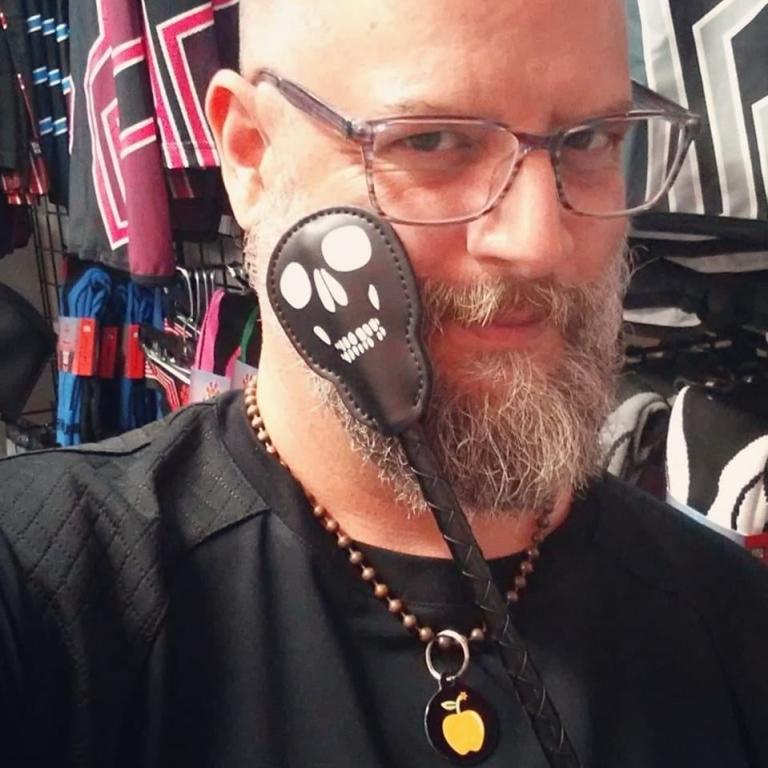I am one week into a 40-day exploration of veiling, and while I didn’t really know what to expect, I was surprised by how quickly things went from “experimentally wearing a hat” to “unpacking childhood trauma.” But I’m sticking with it regardless.
Veiling — that is, covering one’s head as a devotional act — is a fairly recognizable practice in other religions, although it’s only recently gained traction within Paganism. Some of the Pagans and witches who engage in veiling interpret it metaphorically: For them, a “veil” is like an aura that provides protection, or creates a glamour, which emanates from the clothing or jewelry with which they happen to be adorned. For me, though, the idea of a veil is pretty literal: I think of it as something physically worn on or around the head for spiritual reasons.

In a way, I’m glad that veiling can have multiple definitions, because that keeps us from falling into the one-wayism that is so prevalent within Greyface Culture. At the same time, this means that there’s not a lot of concrete information out there on veiling within a Pagan paradigm, nor any set definitions — it’s kind of like shadow work that way. But even if there were a ton of resources available, there still wouldn’t be a right or wrong way to do it.
If history is any indication, at some point, somebody will come forward and say that there is one and only one way to veil — or someone will present a list of all the horrible things that will happen to you if you’re not veiling — and I definitely wanted to give this a whirl before those people find platforms. So instead of approaching it academically and attempting to research it before coming to any conclusions, I figured I would just jump right in.
As to why I am veiling, the focus is entirely devotional. For the duration of the experiment, I don’t want anyone but the Gods I venerate to see all of me — I want to be more open to Them than I am to anyone else. It’s kind of like going skyclad symbolically: My head is naked in my rites and covered the rest of the time. Ideally, this will result in stronger connections in my magical workings and divinations. And while it does sort of imply a level of protection, that’s really just a fringe benefit.
I’ve got friends who veil with hoodies and baseball caps, and in a Reddit thread, I found an intriguing post from someone who veils by tucking crystals into the cuff of a knit beanie. And I am 100% down with that — if I were veiling for protective purposes, I would absolutely go with something innocuous. Because despite what we see on social media, there is a lot of power in keeping silent; in practicing our witchcraft under the radar and hiding in plain sight.

However, I wanted to push myself out of my normal comfort zone with this experiment, and on a psychological level, the goal is for veiling to become a habit (no pun intended). With that in mind, I got hold of some inexpensive biker skullcaps — the kind with tails that tie in the back — and as of February 14, I’ve had one trussed about my scalp every time I leave the house.
I started veiling on Ash Wednesday, because I was raised Episcopalian, and as a kid, I took Lent very seriously. So I wanted to bring the same energy I had as a pious child into this project. Plus I felt like paying homage to the George Romero cult classic Season of the Witch, specifically the scene in which the main character dedicates herself to witchcraft and then dabs fireplace ashes on her forehead to trick her Catholic husband into thinking she’d gone to church.
I also drew inspiration from 1 Corinthians 11, in which Saint Paul (or, depending on who you ask, someone pretending to be Saint Paul) says that men should leave their heads uncovered, because they are made in the glory of God, and women should cover their heads, because they are made in the glory of men. Upon reading that passage, I was like, “Fuck that guy. I’ll do as I please.”
The bravado of blasphemy aside, I swiftly realized that I am not used to something touching my head for 10 hours straight, and that my mostly managed neurospiciness was going to get triggered sooner than later. The skullcaps themselves are not uncomfortable by any means… BUT THEY’RE TOUCHING ME. So I’m going to have to wait and see if that feeling recedes or gets worse. Since I’m basing this whole process around the Anglican interpretation of Lent, I decided to take Sundays off from veiling, just as a precautionary measure against those feelings becoming intolerable, while also being aware of how willing or unwilling I am to push through those feelings.

And since we’re already on the subject, I’m pleased to report that I survived my first veiling-related anxiety attack. I’d gone to make the weekly deposit for work, and as I was walking into the bank, I was suddenly stricken with terror: Out of nowhere, I was convinced that I wasn’t sporty or athletic enough to be wearing headgear designed for outdoorsy folk. I haven’t panicked over an article of clothing in ages — I mean, hell, I wear leather, for Gods’ sake. And yet, a nondescript, microfiber remnant brought me close to unraveling.
Huh. This might turn into shadow work after all.
When I was in college, my Environmental Science class went on a field trip to visit superfund waste sites (which I misheard all semester as “super fun” waste sites), and somewhere out in the wilds of rural Texas, we stopped at a gas station, where I found a bandana durag with big, green jalapeños all over it. I had never seen anything like it, and I immediately fell in love with it, much to the chagrin of my friends, who hated it. And they mainly hated it, because they couldn’t deny how good it looked on me. Even if the aesthetic it gave off was, like, “middle-aged straight dude with three ex-wives who hangs out at a boat club.”
But as much as I adored the durag, I only wore it around the dorms, or to Halloween parties. I rarely, if ever, wore it out in public, because I was deathly afraid of looking silly. As much as I enjoy making people laugh, I do not enjoy being laughed at.

I’ve had a lifelong fascination with eccentric and unusual headwear, but I’m also extremely self-conscious about wearing anything that makes me stand out. I was a nerdy little kid, and my taste in weird accessories did not help the situation: I got laughed at a lot. So part of this whole veiling journey has become healing some of those old wounds, and getting me to the point where I can wear whatever I want with no thought given to what other people think about that.
My operative assumption is that if I spend six weeks with my noggin swathed in uncommon covers, I will come out of the experience with the confidence to wear any damn hat I choose.
So far, the only real impact veiling has had is on my schedule: Can’t leave for work without a veil; can’t put on a veil until after I’ve said my morning prayers at my altar; can’t say my prayers at my altar if I’m lying in bed, playing on my phone and waiting until the last minute to get ready for work. And while the lizard brain of my panic disorder keeps telling me to prepare for jeers and snide remarks, almost no one has even noticed the additions to my wardrobe — the notable exception being my most filterless employee, who walked into the store last Friday and went, “Oh, wow! You look like a non-binary pirate!”
Memories of playground confrontations can take a hike. That alone was all the positive reinforcement I needed to keep on veiling.


















